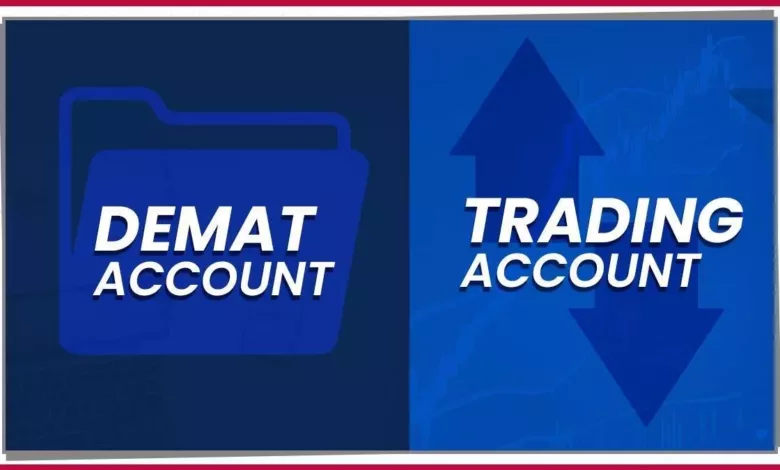Here’s Everything You Need to Know About a Trading Account

Before online trading, stockbrokers were responsible for the buying and selling of securities on their customer’s behalf. With online trading services, you can buy and sell orders whenever you want. In order to do this, you need to have a trading and Demat account. Read on to learn more about what a trading account is and how it works.
What is a Trading Account?
A trading account is an account that allows you to buy and sell securities, such as bonds, stocks, futures, and options in financial markets. They are usually opened with the help of a financial institution or brokerage firm that provides access to trading platforms and tools.
The trading account facility has made investing in stocks, commodities, and currencies more accessible. The increased awareness, advent of computerised trading, and other factors have all contributed to the rise of interest in market investing.
How Does a Trading Account Work?
A trading account serves as an interface between your bank account and Demat account. You can use this account to place an order when you wish to buy shares. The stock exchange will perform this transaction. Upon execution, the appropriate amount is debited from your bank account and the purchased shares are deposited to your Demat account.
Let us see how it works in detail:
- Opening a trading account: You can open an account with a broker or financial institution. This includes filling out an application and providing personal information and submitting identification documents. Once you have opened the account, you can add funds to the same. This can be done via several payment methods, such as credit/debit cards, bank transfers, etc.
- Choosing the securities : Thorough research is crucial before you select the securities you wish to buy or sell. This includes analysing market data, market research, etc.
- Placing the order: You can place an order to buy/sell the securities you prefer through the trading platform. Once the order is placed, the broker or financial institution will execute it on the market on your behalf.
Advantage of Trading Account
There are several advantages of having a trading account:
- Convenience: Access the account from anywhere at any time. You also have complete control over your investments, including when to buy and sell, what securities to invest in, and how much you want to invest.
- Portfolio diversification: Diversify your investment portfolio, which can increase returns and reduce risk.
- Access to financial markets: Access to various financial markets, such as stocks, bonds, commodities, and currencies, allowing you to buy and sell these assets.
- Minimal charges: Low fees can help you save money on transaction costs, processing fees and other expenses associated with investing.
- Help with investments: Research tools and educational resources help you make a wise investment decision. They also provide transparency in terms of charges, and transaction history, allowing you to track your investments.
- Low brokerage fees: There are low brokerage trading accounts where you can pay a flat fee. This way, you do not have to calculate the commission every time you trade in the stock market.
Documents Required for a Trading Account
The steps for opening a trading account and the associated documentation are similar. Here is a list of the various documents you will need to start one.
- Identity proof – Aadhaar Card, PAN Card, Passport, Driver’s License or Voter ID.
- Address proof – Aadhaar Card, PAN Card, Passport, Driver’s License or Voter ID, rental agreement or bank statement.
- Income proof – net-worth certificate, 6 months bank statement, ITR statement, Demat holding statement or report
- Bank account proof – A cancelled cheque or bank statement that shows your name, IFSC code and account number.
- Signature on white paper
- Passport-size photographs
- Other documents – Additional documents may be required, depending on the type of trading account, such as income proof, trading experience, etc.
How to Open a Trading Account?
To open a Trading Account, you can follow these steps:
- Select a broker: The first step is choosing a broker who is ideal for your trading and investment needs.
- Complete the application: You must complete the broker’s application form after making your choice. The application will include your name, address, PAN card number, bank account information, etc.
- Submit the required documentation: You must submit the necessary documentation as specified by the broker, including identification, proof of address, a PAN card, proof of a bank account, and passport-size photos.
- Finish the verification process: The broker will check your paperwork and application to make sure you meet their specifications. This could include a video verification, an e-KYC verification, or an in-person verification.
Types of Trading Account
There are several types of trading accounts available. Here are some of the most common types:
- Equity Trading Account: Investors can purchase and sell shares on the stock market using this type of account. It is the best option for people who want to invest in stocks for short-term trading or for long term.
- Commodity Trading Account: Trading in commodities like gold, crude oil, silver and agricultural goods takes place through this account. It is right for people who want to trade non-equity assets and diversify their portfolio.
- Derivatives Trading Account: Derivatives like options and futures are traded using this type of account. It is perfect for seasoned traders who want to utilise leverage and hedging techniques to control the risk of their portfolio.
Online trading has made the process of doing equity trading and fund transfer procedure seamless and hassle-free. With the help of an online trading account, you can trade easily and conveniently. Make sure to do your research before you choose the trading platform that best suits your needs and requirements.




